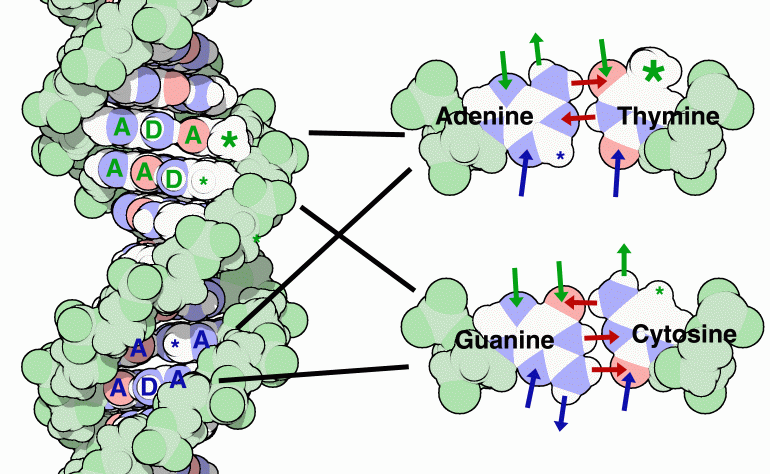Karsten Theis sandbox 1
From Proteopedia
This page, as it appeared on August 20, 2011, was featured in this article in the journal Biochemistry and Molecular Biology Education.
Deoxyribonucleic acid or DNA is a molecule which is the carrier of genetic information in nearly all the living organisms. It contains the biological instructions for the development, survival and reproduction of organisms. DNA is found in the nucleus of a cell where it is packaged into a compact form called a chromosome with the help of several proteins known as histones. It is also found in cell structures called mitochondria. However in case of prokaryotes DNA is not enclosed in a nucleus or a membrane but is present in the cytoplasm. The DNA in prokaryotes in generally circular and supercoiled without any histones. DNA stores genetic information as a sequence of nucleotides in special regions known as genes which are used to make proteins. The expression of genetic information into proteins is a two-stage process wherein the sequence of nucleotides in DNA is converted to a molecule called Ribonucleic acid or RNA by a process called transcription. RNA is used to make proteins by another process called translation. The human genome contains nearly 3 · 109 bases with around 20,000 genes on 23 chromosomes. [1]
DNA was first discovered by the German biochemist Frederich Miescher in the year 1869.[2] Based on the works of Erwin Chargaff, James Watson, Francis Crick, Maurice Wilkins and Rosalind Franklin, the structure of DNA was discovered in the year 1953. The structure of DNA is a : two complementary strands of polynucleotides that run in opposite directions and are held together by hydrogen bonds between them.[3] This structure helps the DNA replicate itself during cell division and also for a single strand to serve as template during transcription. [1]
| |||||||||||
See Also
Proteopedia Articles
- Forms of DNA
- 1ply
- DNA Replication, Repair, and Recombination - Articles in Proteopedia concerning DNA Replication, Repair, and/or Recombination
- DNA Replication,Transcription and Translation
- Z-DNA
- Transfer ribonucleic acid (tRNA)
- For additional information, see: Nucleic Acids
External Resources
- DNA.MolviZ.Org, an interactive DNA Structure tutorial that is available in nine languages.
- DNA / RNA Section of the Atlas of Macromolecules.
Interpretation of X-Ray Diffraction by DNA
- Anatomy of Photo 51, Rosalind Franklin's diffraction pattern used by Watson & Crick in developing their model of the DNA double helix (at PBS.Org, US Public Broadcasting System).
- Explanation of Franklin's X-Ray Diffraction Pattern at Cold Spring Harbor Laboratory, USA.
- More technical: How Rosalind Franklin Discovered the Helical Structure of DNA: Experiments in Diffraction.
References
- ↑ 1.0 1.1 http://www.genome.gov/25520880
- ↑ Dahm R. Discovering DNA: Friedrich Miescher and the early years of nucleic acid research. Hum Genet. 2008 Jan;122(6):565-81. Epub 2007 Sep 28. PMID:17901982 doi:10.1007/s00439-007-0433-0
- ↑ 3.0 3.1 A Structure for Deoxyribose Nucleic Acid Watson J.D. and Crick F.H.C. Nature 171, 737-738 (1953)
- ↑ 4.0 4.1 4.2 Watson, James D, Nancy H. Hopkins, Jeffrey W. Roberts, Joan Argetsinger Steitz, Alan M.Weiner Molecular Biology of Gene (4th ed.). The Benjamin/Cummings Publishing Company Inc.pp. 239-249. ISBN 0-8053-9612-8
- ↑ SantaLucia J Jr. A unified view of polymer, dumbbell, and oligonucleotide DNA nearest-neighbor thermodynamics. Proc Natl Acad Sci U S A. 1998 Feb 17;95(4):1460-5. PMID:9465037
- ↑ Saenger, Wolfram (1984). Principles of Nucleic Acid Structure (1st ed). Springer-Verlag. pp. 398. ISBN 0-12-645750-6.
- ↑ Rawn,David J. "Biochemistry"(1st ed.) Harper&Row,Publishers, Inc.pp. 1024-1050. ISBN-0-06045335-4
- ↑ Maddox, Brenda: Rosalind Franklin: Dark Lady of DNA, HarperCollins, 2002
- ↑ Berman HM, Gelbin A, Westbrook J. Nucleic acid crystallography: a view from the nucleic acid database. Prog Biophys Mol Biol. 1996;66(3):255-88. PMID:9284453
- ↑ Chandrasekaran R, Arnott S. The structure of B-DNA in oriented fibers. J Biomol Struct Dyn. 1996 Jun;13(6):1015-27. PMID:8832384

